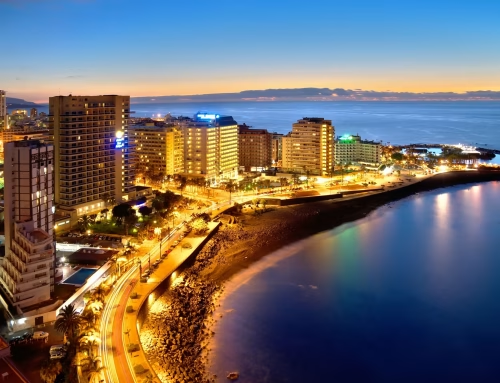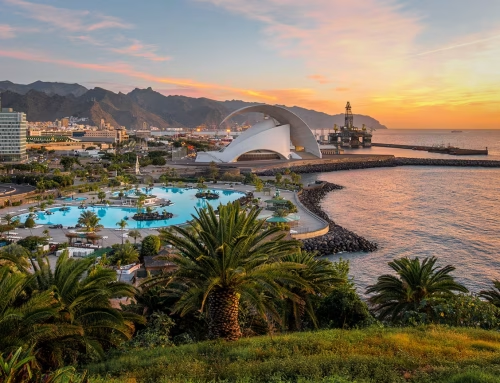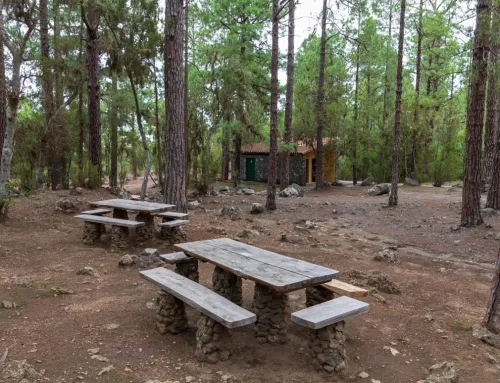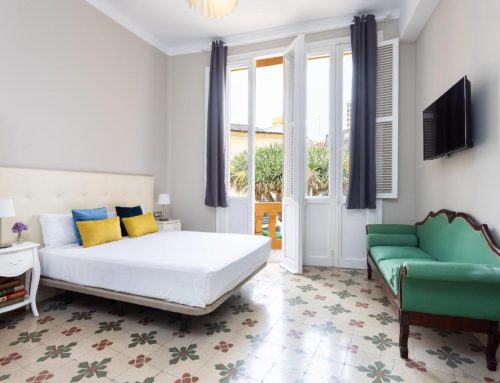With this list of places to see in Costa Adeje, you’ll be able to make the most of your next vacation in one of the most famous corners of Tenerife. You’ll discover the best beaches in the area, as well as cultural and entertainment attractions that will give you a more complete vision of it.
Adeje is the fifth most populated municipality in Tenerife and also one of the island’s most touristic places, thanks to its fantastic climate and its proximity to Tenerife South Airport, which receives passengers from all over the world. Here you will find beautiful beaches, natural spaces such as the spectacular Barranco del Infierno (Hell’s Gorge), and a huge variety of five-star hotels or resorts, restaurants, golf courses, and shopping centers so that you don’t lack anything during your vacation.
It is believed that it was in Adeje—meaning “mountain massif” for the Guanches—where the last king or mencey, Tinerfe el Grande, lived in the late 14th century. The municipality is divided into 8 towns, which in turn are divided into smaller districts, with Costa Adeje being the most important in terms of tourism and the one almost all travelers choose. Therefore, here we will focus on telling you about things to do in Costa Adeje, although we will also talk to you about many other places to visit in Adeje, including Adeje Casco (the historic center).
How many days are needed to see Costa Adeje? That’s a difficult question to answer because it largely depends on your plans. You could stay for weeks enjoying its beaches or maybe just a couple of days if your goal isn’t to relax. To decide how long to stay, we recommend reading this post carefully and, once you’ve decided which places to visit or which experiences to have, figure out how many days you need to carry out your plans.
Based on our experience visiting the archipelago—thanks to which we wrote this selection of places to see in the Canary Islands—below we’ll show you the best things to do in Adeje (Tenerife), tips, and a map to help you get your bearings. Let’s begin!
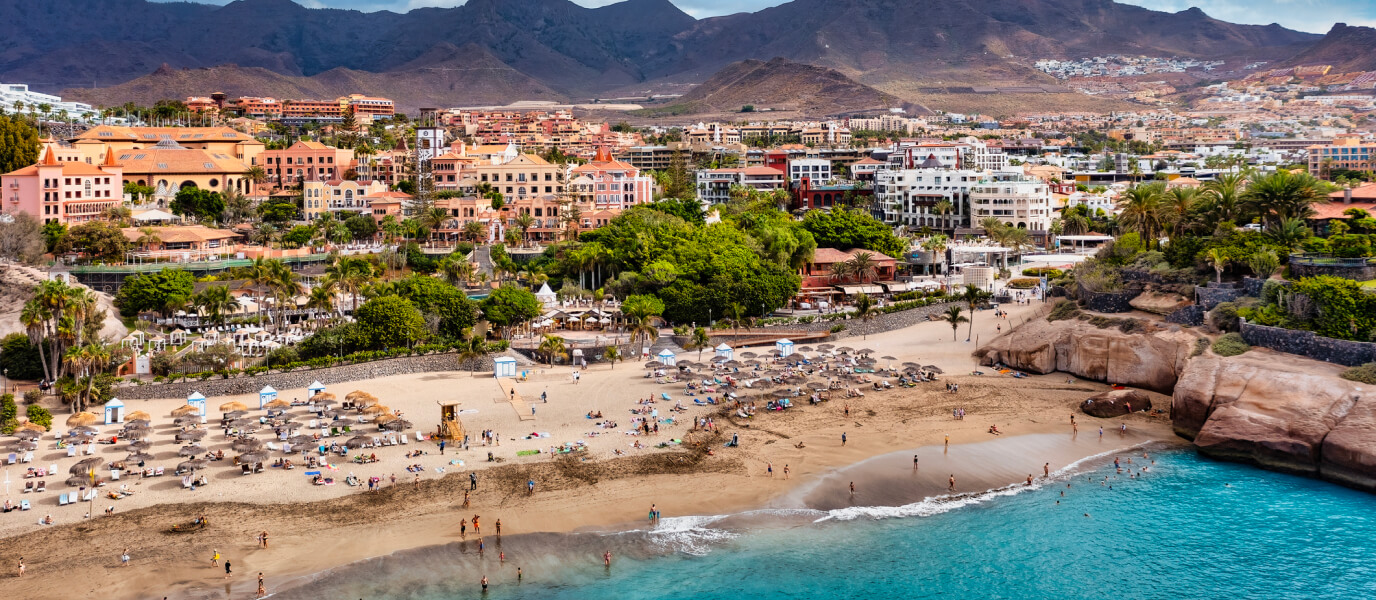
1. Playa del Duque
As we’ve already mentioned, this part of Tenerife is predominantly touristic, thanks to the warm climate all year round (the average annual temperature is 24°C, and it’s estimated that there are almost 300 sunny days). This allows you to enjoy the beaches even in the middle of January. Therefore, one must-do in Costa Adeje is to take the opportunity to explore some of its beaches and savor the sun and sea that we often miss so much.
Costa Adeje has approximately 26 kilometers of coastline, so you can choose from 21 beaches and coves. Throughout this guide, we’ll tell you which ones we found most beautiful, but we couldn’t start with any other than Playa del Duque, which, along with Fañabé and Torviscas, is one of the main ones.
Awarded a Blue Flag, which guarantees the quality of the water and the surrounding services, Playa del Duque is perfect if you want to not worry about a thing. Considered one of the best beaches in Tenerife, it offers restaurants, bars, restrooms, lifeguards, sun loungers, shopping centers, and some of the island’s best resorts in its vicinity. The sand is white/grayish, and the sea is usually calm since there is a breakwater that limits the waves.
Although it’s usually less crowded from Monday to Friday, keep in mind that in summer months and on weekends, you will indeed find people there, as it’s one of the best-known places to see in Costa Adeje. Even so, it’s not typically overrun.

2. Barranco del Infierno, a must-do in Costa Adeje
It’s not just beaches in Costa Adeje; there are also some very interesting hiking routes in the area, the standout being the Barranco del Infierno (Hell’s Gorge). It is a spectacular trail that starts in Adeje Casco and takes you through this ravine with enormous rock walls up to 1,300 meters high, ending at a lovely waterfall of about 200 meters.
Beyond the waterfall, the trail is very beautiful, with magnificent formations of cardones and tabaibas, as well as dragon trees and Canary Island pines. With luck, you can see some of the 40 endemic species in the ravine, such as the common kestrel, the buzzard, the crow, the sparrowhawk, or the robin.
For its protection, it has been declared a Special Nature Reserve, and therefore only 20 people are admitted every 30 minutes within set hours. The route is not circular; you go back the same way you came, and it will take you between 2 and 3 hours, depending on your stops. The elevation gain is very moderate, so you don’t need to be in top physical shape to complete it. Along the way, you’ll find some informational boards about the local flora and fauna, and they also give you a map at the beginning.
Since tickets often sell out at the box office—remember it’s one of the best-known places to see in Costa Adeje—we advise you to book at least a day in advance from the official website. You must wear sports shoes, and if they’re hiking shoes, all the better. We also recommend wearing sunscreen and bringing water. The use of a helmet, which they will provide at the entrance, is mandatory at all times.
Ticket price: €11 for non-resident adults in the Canary Islands, €4.50 for residents, €5.50 for non-resident children aged 5 to 12, and €2.25 for resident children.
Schedule: From June 1 to September 15, you can enter from 8:00 a.m. to 10:30 a.m. (park closes at 2:00 p.m.), and from September 16 to May 31, from 8:30 a.m. to 11:30 a.m. (park closes at 2:30 p.m.).
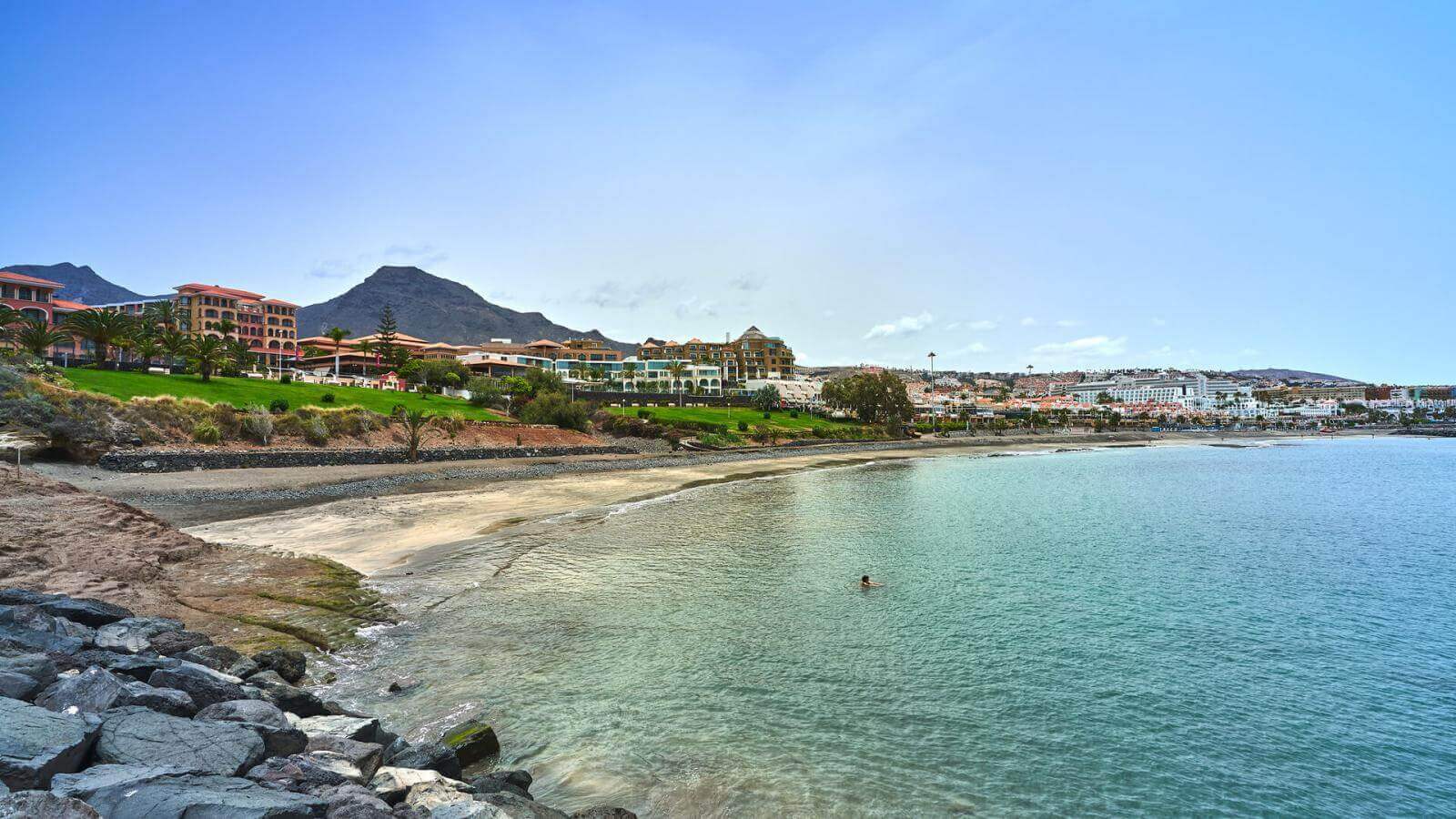
3. Playa de Fañabé and Playa de Torviscas
We won’t say it’s a particularly photogenic or tranquil beach, but Fañabé Beach is one of the best beaches in Costa Adeje if you want a bit of “liveliness.” There are many beach clubs with sun loungers or Balinese beds where music plays almost any time of day, as well as restaurants, beach bars, souvenir shops, and bars.
Being in an area of large hotel complexes, it’s rare to find it empty, but it’s convenient if you don’t want to prepare much for a beach day. That is, along its nearly 600-meter length, you’ll find lifeguards, restrooms, showers, parking, and opportunities to do all kinds of water sports (jet skis, banana boats, etc.). The same goes for Torviscas Beach, which continues from Fañabé and stretches about 300 meters.
Finally, if you’re thinking of visiting Costa Adeje with children, these beaches are also perfect for them, as the water is usually quite calm thanks to the breakwaters.

4. Playa de Diego Hernández, the best beach to see in Costa Adeje
The previous ones are good, but if you don’t mind walking a bit, something we consider a must-do in Costa Adeje is to visit Playa de Diego Hernández. In our opinion, it’s the most beautiful and pleasant beach in all of Tenerife, thanks to its surroundings, golden sand, and transparent water.
Also known as La Caleta de Adeje (that’s how you’ll find it labeled in Google Maps), it’s one of the most unspoiled beaches on the island because it lies below a cliff. The walk from where you park your car won’t take more than 15 minutes, but note that the way back is uphill, so it’s advisable to save some energy and wear good footwear to avoid slipping. Additionally, we recommend checking the tide tables to try to time your visit with low tide, as the sandy area shrinks considerably at high tide.
At Diego Hernández, you won’t find any services, bars, or restaurants, so you’ll need to bring everything you might need. It’s also a beach where nudism is allowed (and common), though you’ll find more and more “textile” visitors.
If you don’t feel like walking but still want to visit one of the best-known places to see in Costa Adeje, there are various excursions in Tenerife that arrive here by boat. Like this catamaran tour, which includes snacks and an open bar.
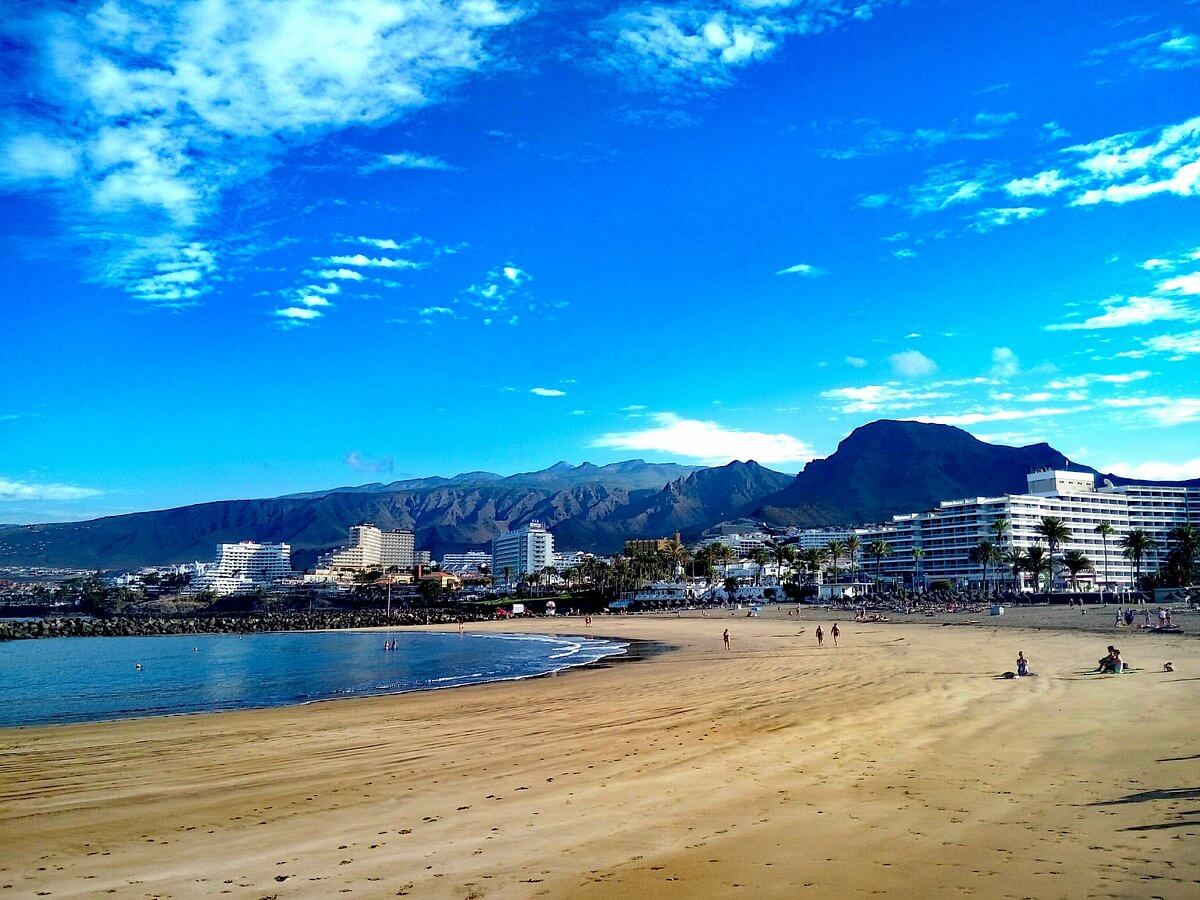
5. Other Beaches to See in Adeje
If you have more time to explore Adeje’s beaches or want to see if there are any closer, here’s a brief summary of the most interesting ones in this part of Tenerife:
- Playas de Troya: This group of two beaches, commonly called Troya I and Troya II, is perfect if you’re visiting Adeje with children, since the water is usually calm. They feature volcanic sand and a promenade with a wide variety of restaurants and bars. They tend to be quite busy.
- Playa de Ajabo: Located in the quiet area of Callao Salvaje, it’s a small cove about 100 meters long that generally isn’t very crowded. Be mindful of waves and currents.
- Playa de El Bobo: Very close to the Troya beaches, it’s a small beach shaped like a bay, so the waters are calm. There are quite large hotels around, so it’s normal to find many bathers here.
- Playa de La Pinta: Located next to Puerto Colón—where many boat tours in Costa Adeje depart from—it’s a beach with golden sand that’s usually full of people because there are many restaurants, bars, and shops in its surroundings. It doesn’t have much charm, but it’s okay for a quick swim if it’s convenient for you.
- Playa de La Enramada: If you like a calmer atmosphere, this beach lies between Playa del Duque and La Caleta and is made of black gravel (crushed pebbles), so water shoes are recommended. Note that the waves can be quite strong here, so caution is advised. There is a beach bar that rents umbrellas and sun loungers.
Remember that at the end of this guide, you’ll find a map of Costa Adeje where we have marked all these beaches, as well as other points of interest.
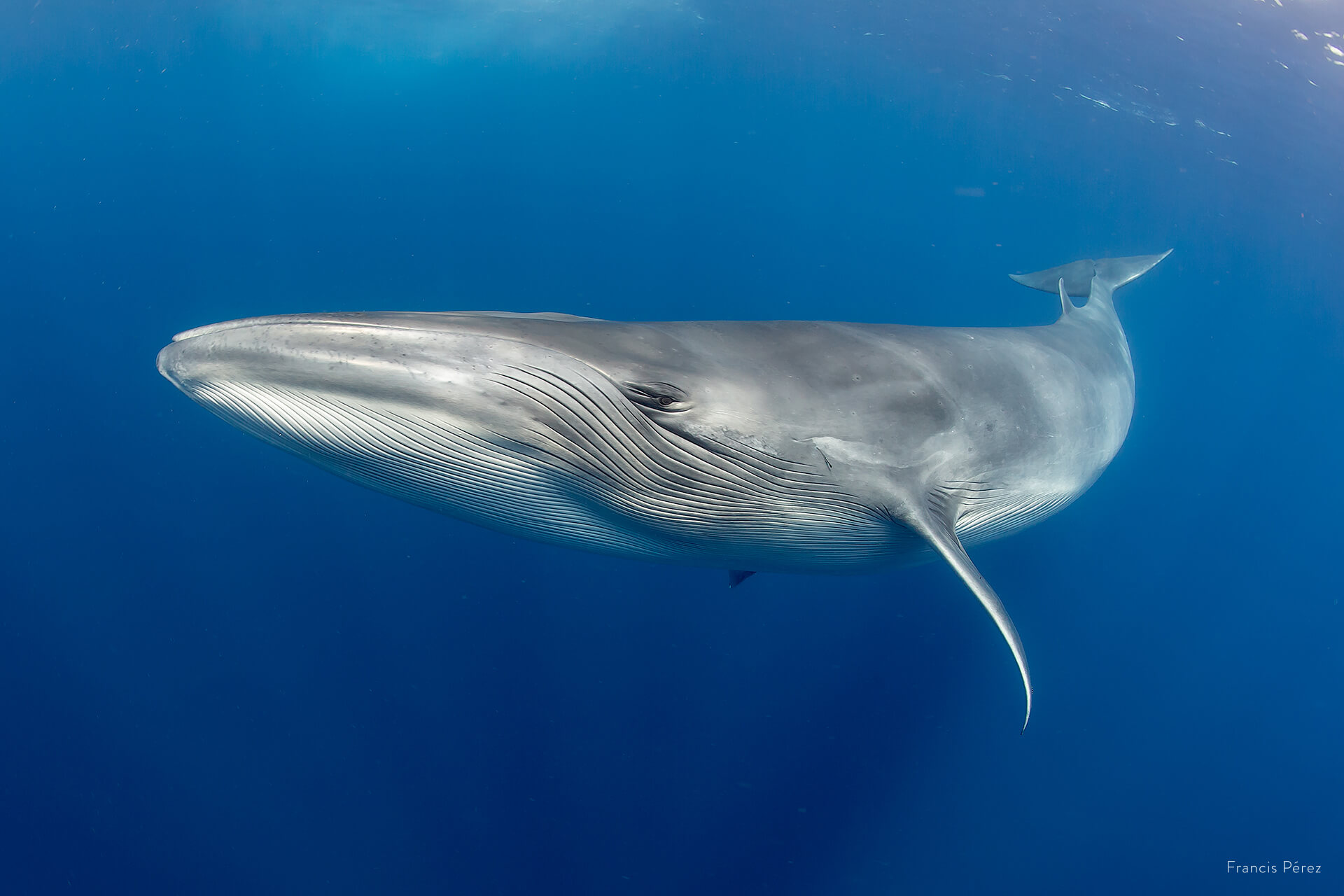
6. Whale Watching in Costa Adeje
The maritime channel between Tenerife and La Gomera is home to over 20 species of cetaceans or marine mammals such as sperm whales, pilot whales, and bottlenose dolphins, which inhabit the area all year round. Thus, it’s entirely possible to see them in the wild while you also enjoy the scenery of Costa Adeje, with Mt. Teide watching from afar.
Because this is an activity involving wild animals, be aware that sightings, though very common, are not 100% guaranteed, as they depend on currents, weather, and other factors. These tours are also respectful toward the animals, so you must understand that swimming with them is strictly prohibited and that boats must keep a safe distance. Even so, many of these excursions do allow for a swim in open water and, in some cases, a bit of snorkeling.
Here are the best excursions to do in Adeje to see cetaceans:
- 3-hour catamaran tour with whale watching and listening: Departs from Puerto Colón in Costa Adeje in a beautiful catamaran. There’s a stop for a swim and snacks, sandwiches, and an open bar are included.
- Sailboat tour with whale watching: Similar to the previous one, but more “private,” as you’ll be on a sailboat that holds up to 11 people. If you like a more personal experience, this Tenerife tour is for you.
- 5-hour catamaran tour with whale watching and listening: Very similar to the first one, but in addition to including lunch (rice with chicken and vegetables and open bar), you’ll get to see Los Gigantes from the sea, with its spectacular cliffs. It also stops for a swim in Masca Bay. For us, it’s a must-do in Costa Adeje.
- Schooner tour with whale watching and food: The same as the previous one but on a schooner, a traditional-style boat.
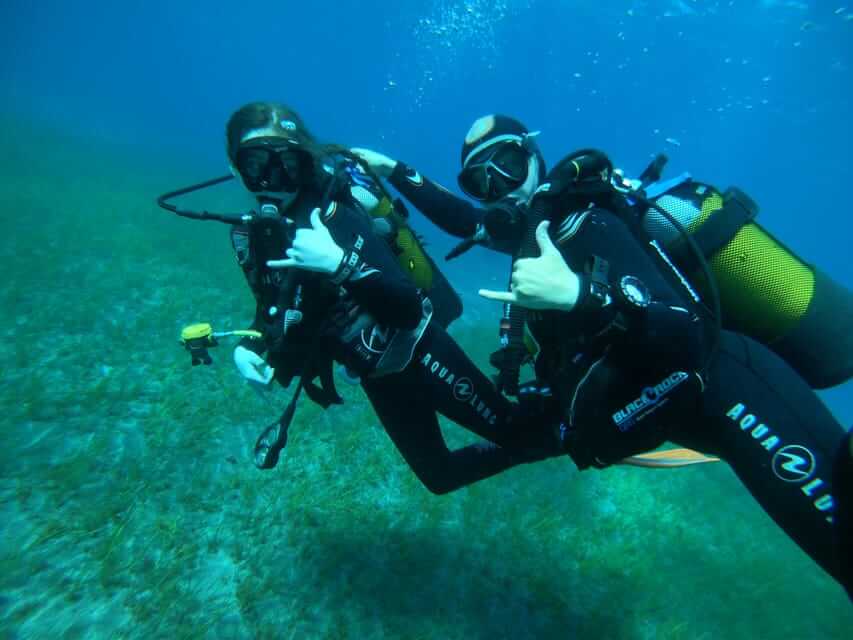
7. Snorkeling and Diving
As you can see, there are many things to do in Costa Adeje related to the sea, and of course, you also have the chance to enjoy the underwater world by scuba diving and/or snorkeling. The Canary Islands boast some of the best sea floors in Europe, with abundant marine flora and fauna and fairly pleasant water temperatures, especially in the summer months.
If you still don’t have your Open Water Diver certification, you might be tempted to do a trial dive in Costa Adeje, which takes place in the Protected Natural Reserve of La Caleta de Adeje. This is an ideal spot to start out, with calm waters and varied marine life. With some luck, you may even see green turtles.
If you’re already a certified diver, there are several interesting dive sites in and around Costa Adeje, such as Los Gemelos, where you can explore two shipwrecks in Puerto Colón; the Punta Rasca Lighthouse, filled with tunnels, arches, and caves; or the Cueva del Palmar, where the wall teems with marine life.
If you don’t feel like trying scuba diving, the best area for snorkeling on your own is El Puertito de Adeje, where you can spot several species of tropical fish and the occasional turtle. Even so, we highly recommend you check out this guided excursion, which also includes photos, or this other one, which takes place in the so-called Palm-Mar wall, home to a large population of green turtles.
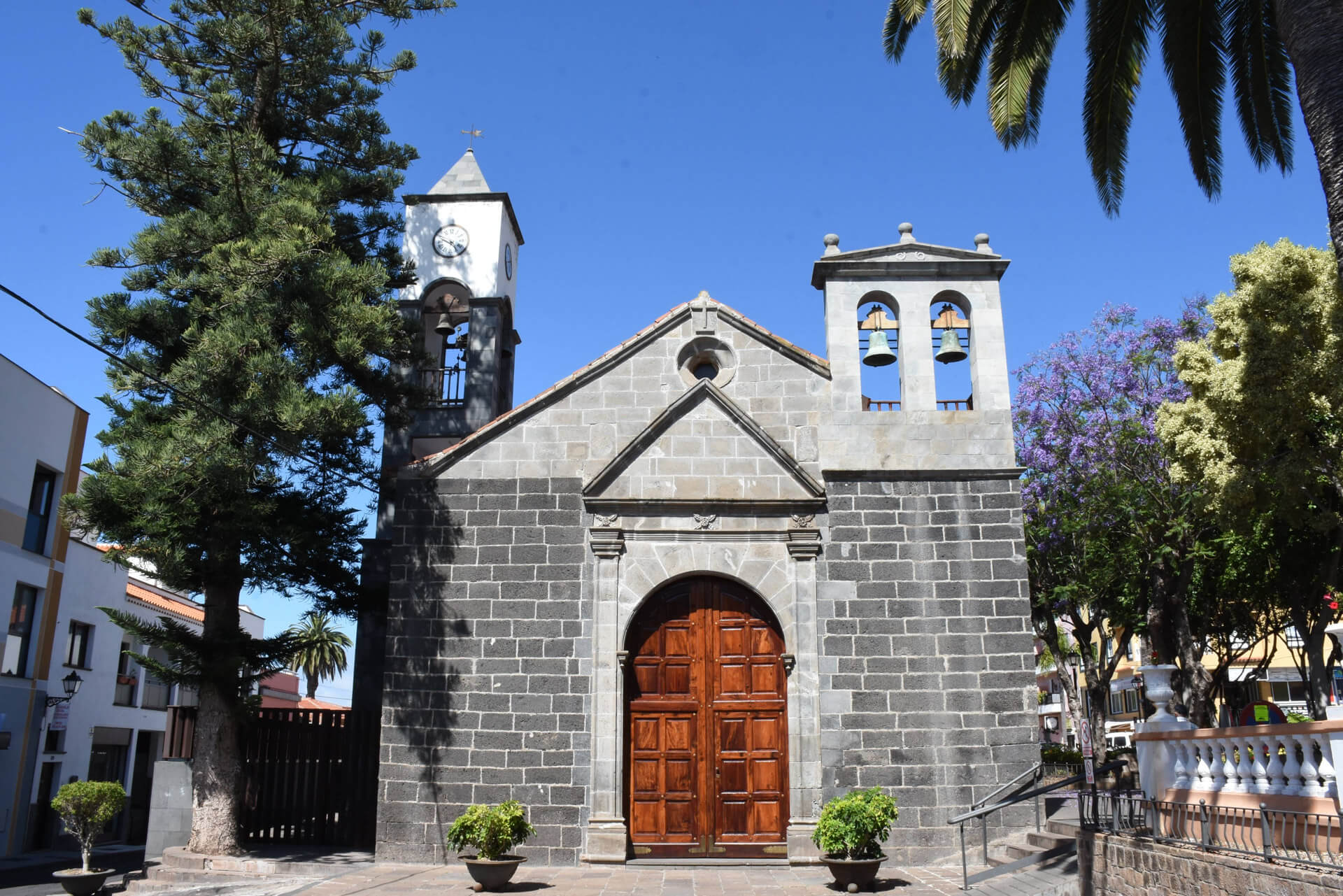
8. Parroquia de Santa Úrsula, a lovely place to see in Adeje
If you’re considering visiting Adeje Casco, the most important spot is the Santa Úrsula Church (Parroquia), located on the site of an old chapel from the early 16th century and one of the first religious buildings in the south of the island after the conquest—also one of the places to see in Costa Adeje.
The building consists of two naves: the one on the left, dating from the 16th century, and the main one, built by the Marquises of Adeje in the 17th century. Admission is free, and inside you can admire a beautiful Mudejar-style ceiling and the statue of the Virgen de la Encarnación (patron saint of Adeje), carved in wood in the 16th century.
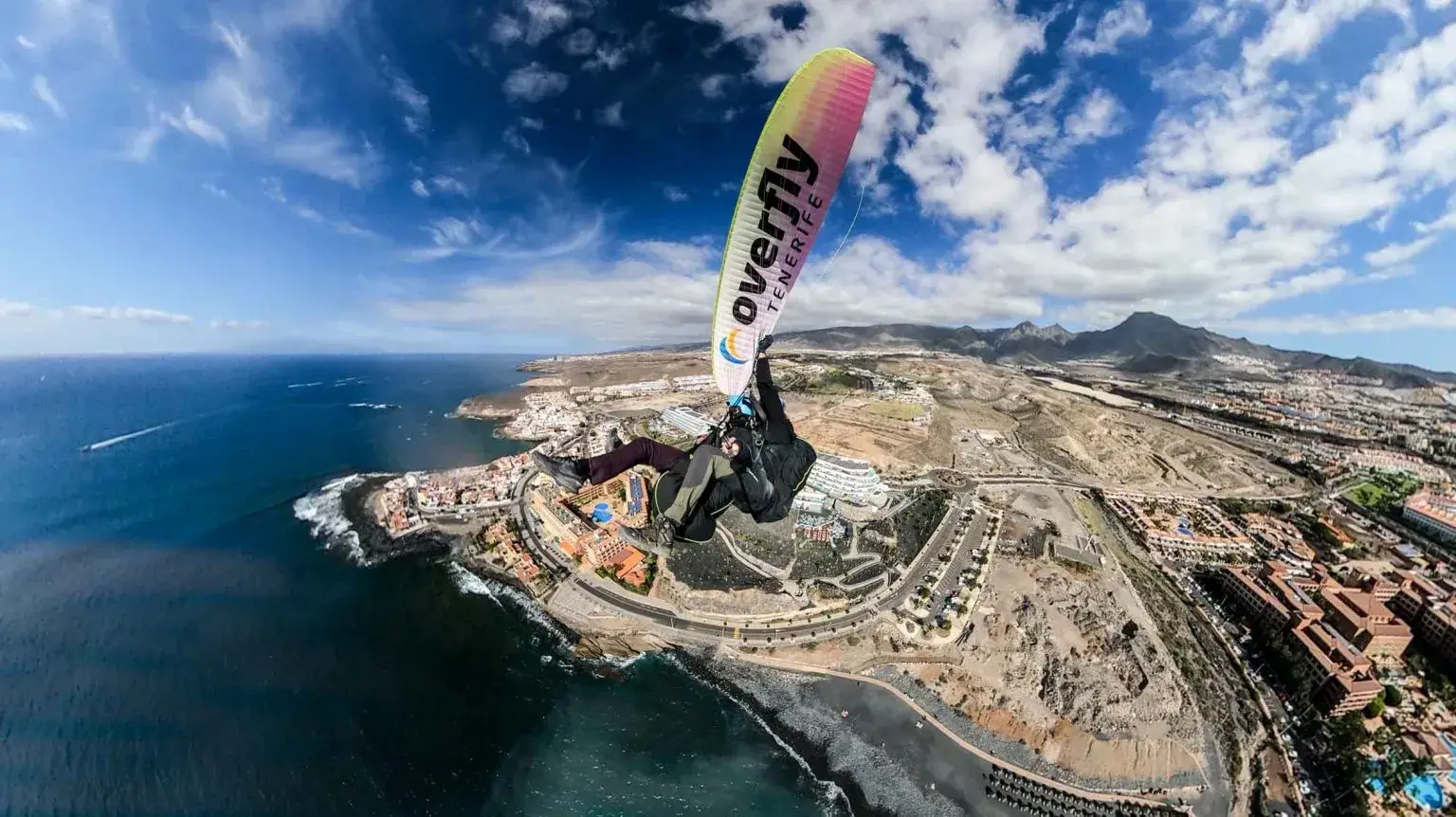
9. Paragliding in Costa Adeje
It would be unusual not to see a paraglider in the sky during your visit to Costa Adeje. Why? Because Tenerife is one of the best destinations to enjoy from a bird’s-eye view, and opportunities for paragliding are spread throughout the island, including Adeje.
Whether you’ve tried it before or not, we recommend it because you’ll get to enjoy a panoramic view of the sea, reaching about 700 or 1,000 meters in altitude, depending on the option you choose. If you go for the longer flight, you can also see Barranco del Infierno from above and, of course, the omnipresent Teide. You can book it through this link.
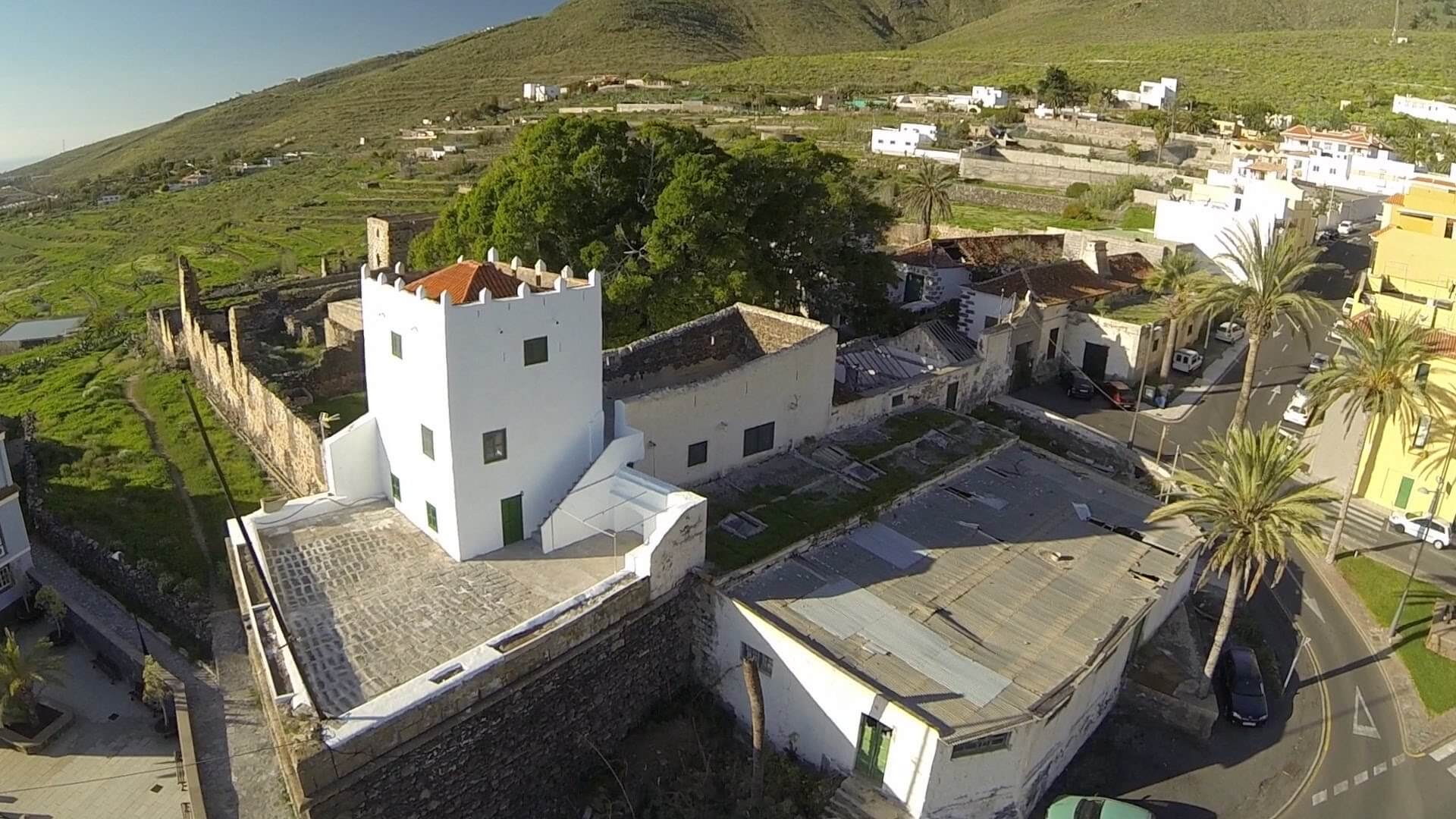
10. Casa Fuerte de Adeje
Another spot to visit in Adeje Casco is the Casa Fuerte (Strong House). It was a palace-fortress built in 1556 that served as the residence of the wealthy Ponte family and as a protective structure against raids by French and English pirates arriving on Adeje’s shores.
Casa Fuerte was, for more than 300 years, the political, economic, and social center of Adeje, as well as the symbol of the seigniorial regime of the Ponte family. It featured a castle and keep, storage rooms, granaries, stables, a smithy, ovens, a prayer room, the palace where the owners lived, and housing for their employees.
Although there’s still much work to do, one family, without government support, is gradually restoring it, and you can visit some of its rooms, which also contain a few old artifacts.
Admission: Free.
Opening hours: 10:00 a.m. to 1:00 p.m.
11. Enjoy the Sea, a must-do in Costa Adeje
We’ve already mentioned some tours for whale watching, diving, and snorkeling, but there are also several boat trips you can take in Costa Adeje to enjoy its landscapes from the sea in a more relaxed way. The choices are numerous, but here’s a selection of the best:
- Catamaran Tour around Costa Adeje: A 3-hour trip along the Costa Adeje coastline, during which you’ll receive interesting information about the area and have the chance to swim off the beautiful Diego Hernández Beach. It includes snacks on board and unlimited sangria, beer, and soft drinks.
- Sailboat Tour from Costa Adeje: A more intimate excursion on a sailboat for up to 10 people. The trip lasts about 3 hours and also includes a sandwich, snacks, and drinks.
- Boat Rental without License in Costa Adeje: After receiving basic instructions, you can sail on your own for 4 hours, plenty of time to reach Los Gigantes and return. It’s an ideal activity in Costa Adeje if you’re traveling in a group or as a couple and want something different.
- Boat Rental with Skipper in Costa Adeje: If you like the idea of something private but are afraid to steer the boat yourself, book this option, which comes with a certified skipper.
12. More Things to Do in Costa Adeje
We’ve mentioned the main spots to see in Costa Adeje, but being such a touristy area, there are of course many more. Here are some additional activities that might interest you:
- Relax at Aqua Club Termal: This is one of the island’s largest spas, with several whirlpool pools, a sauna, a Turkish bath, relaxation areas, a massage room, etc. If you’ve come to Tenerife in search of wellness, it could be a great plan. Buy your ticket at a good price from this link.
- Light Park Tenerife: If you’re looking for things to do in Adeje with kids, this theme park with more than 800 silk sculptures illuminated at night will delight them.
- Take a stroll around La Caleta: This former fishing village is a pleasant place to walk around or grab a meal at one of its restaurants specializing in fresh seafood.
- Parasailing: It’s one of the water activities you can do from Puerto Colón. You’ll reach 100 meters above the sea, and in addition to getting an adrenaline rush, you’ll enjoy views of Costa Adeje. Book from this link.
- Discover Costa Adeje’s nightlife: Being a vacation spot, there are many options to extend your day. You can party until the early hours at clubs like Papagayo Tenerife, end the day at Kaluna Beach Club, attend a burlesque show like Scandal Dinner Show, or enjoy dinner with the vibe of the legendary Hard Rock Café Las Américas.
- Go shopping: Whether you need something or just want to browse, there are lots of shopping centers at your disposal. The most famous are Siam Mall (the largest in Tenerife), Centro Comercial Plaza del Duque, Galeón Outlet, Centro Comercial El Mirador, The Duke Shops, and X-Sur (with a movie theater). There’s also a market next to Centro Comercial Plaza del Duque every Thursday and Saturday from 9 a.m. to 2 p.m.
All we ask is that you please research well the activities you can do in Costa Adeje, as many involve the use and mistreatment of animals. Zoos, dolphinariums, camel rides, and similar activities are unfortunately very common in this area. We also haven’t included the famous Siam Park, which belongs to the same company as Loro Parque, because they also keep animals in captivity, something we do not support at all. Not contributing in any way to the promotion of such places also means being responsible tourists.
Excursions in Costa Adeje
Although you can see there is no shortage of activities to do in Costa Adeje, there are also many possible excursions all over the island. Here is a summary of the most interesting excursions in Tenerife that we think are worth it from this area:
- Visit El Teide: If it’s your first time on the island, you can’t leave Tenerife without going up Mt. Teide. You can go on your own to Las Cañadas del Teide, but if you want a worry-free trip or prefer a guide, there are various tours that might suit you. For example, this excursion with a cable car ticket, this one that includes permits and a guide to climb to the Teide summit, a quad tour, a jeep safari through Teide and Masca, the same jeep safari but only through Teide, a night excursion to Las Cañadas del Teide, or an astronomy tour.
- Masca and Los Gigantes: These two attractions in Tenerife are located in the same area, so it’s convenient to visit them in the same day. The first is known as the Machu Picchu of Tenerife because it’s a traditional Canarian village surrounded by an environment reminiscent of the Peruvian wonder. The second is a spectacular set of cliffs over 500 meters high that will amaze you. To explore them, you can sign up for this excursion.
- Icod de los Vinos and Garachico: Discover the best spots in the so-called Isla Baja, two of the most charming towns on the island. This excursion also includes a visit to Teide.
- Santa Cruz, La Laguna, and Taganana: You can also explore Tenerife’s two main cities, cross the impressive Anaga Massif, and reach the traditional village of Taganana with this complete tour.
- Tour of Tenerife: If you don’t have much time, you can join this tour that goes around the entire island from the south and visits places like Candelaria, San Cristóbal de La Laguna, La Orotava, Garachico, and Masca. If you’re traveling in a group or as a couple and want to optimize your time, there are also private tours through different parts of Tenerife.
- Wine Tasting: In the south of Tenerife, specifically in the municipalities of Vilaflor and Granadilla de Abona, you’ll find excellent wines, especially whites. Learn more about this aspect of the island with this wine tour in southern Tenerife.
If you plan to rent a car—which we believe is the best way to make the most of your time in Tenerife—you can also explore places like Los Gigantes or El Médano in the south, or Candelaria, La Orotava, Icod de los Vinos, Garachico, La Laguna, or Santa Cruz de Tenerife in what is considered the north.
Where to Stay in Costa Adeje
The accommodation options in Costa Adeje are endless, as it’s one of the most touristic areas in all of Tenerife. Here, you’ll mainly find resort-type hotels with large pools, and some offer all-inclusive plans. Since it’s quite a big area, we strongly recommend you pay attention to the location, especially if you want to be near the beach and don’t plan on renting a car. In any case, it’s one of the best areas to stay in Tenerife if you want to enjoy good weather and the sea.
Below are some suggestions for accommodations in Costa Adeje that offer excellent value for money:
- Vincci Selección La Plantación del Sur: Located just steps from Playa del Duque, this is undoubtedly one of the classiest hotels in the area. With modern, well-maintained facilities including 5 pools, a spa, and two restaurants, you can treat yourself to the rest you deserve. You can choose between bed & breakfast or half board (breakfast and dinner). It’s perfect if you plan to visit Costa Adeje with children.
- Melia Jardines del Teide – Adults Only: Although slightly further from the beaches, this resort is one of the most spectacular places to stay in Costa Adeje, thanks to its well-kept rooms and 12,000 square meters of tropical gardens full of pools. Some of its rooms have sea views. Keep in mind it does not allow children, as it’s a hotel designed for couples.
- H10 Costa Adeje Palace: Located just 50 meters from La Enramada Beach, this is another fabulous hotel for exploring Costa Adeje with family or as a couple, as it offers romantic suites with sea views, as well as spacious family rooms and a small children’s water park.
If the above options don’t convince you or are fully booked, we suggest taking a look at Booking, which is the accommodation search platform we always use on our trips.
How to Get to Costa Adeje
First of all, to get to Costa Adeje, you’ll need to look for a flight to Tenerife. Although Tenerife North Airport often has more frequent flights from mainland Spain, Tenerife South Airport is much closer—specifically, 23 kilometers from Adeje. Low-cost airlines such as Ryanair, Vueling, or EasyJet fly there, so if you book in advance, you can get good prices.
Once you’ve arrived in Tenerife, the best way to get to Costa Adeje is by renting a car, as this allows you to explore the island at your own pace without relying on buses (guaguas). Rental offices are available at both the airport and the port.
If you don’t want to drive or don’t have a license, you can also take the number 40 bus (guagua), which will drop you at the Costa Adeje bus station in about 30 minutes. From there, you can connect to other guaguas that go to various places in the area. If you want to reach Adeje Pueblo, the best line is the 447, taking about 25 minutes. You can also get to Fañabé, Playa Paraíso, Callao Salvaje, or Playa del Duque.
You can check more information about transportation on the island and other details in this list of tips for traveling to Tenerife.
Map of Places to Visit
To help you better navigate, we have created this map where we mark the different things to see in Costa Adeje:
We hope we have helped you prepare your visit with this selection of places to see in Costa Adeje. If you have any questions or suggestions, you can leave them in the comments.

